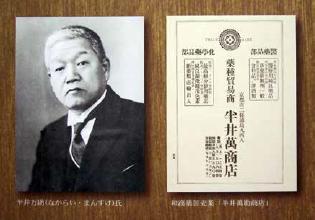The Story of Nakarai
The Story of Nakarai
The Nakarai family served for many years as the head physicians of the imperial household, and could have been considered the most prestigious medical family in Japan. They were originally called Wake-descendants of Kiyomaro Wake and of Emperor Suinin 15 generations before him.
The Wake residence was in the former site of the Seyakuin Temple (currently part of the Kyoto Imperial Palace Park), and they made their medicines there. There was a large well with pure and delicious water in the residence. From one side of the well water was taken for the emperor' s medicine, and from the other side they took water for their daily use. Emperor Go-Kashiwabara heard of this, and gave the Wake family the name "Nakarai," which means "half-well."
 A statue of Kiyomaro Wake (Goou Shrine)
A statue of Kiyomaro Wake (Goou Shrine)
Ishinpō
Ishinpō (30 scrolls) is the oldest surviving medical text in Japan. A copy belonging to the Nakarai family was used to reproduce the version we have now. The Nakarai copy then became a national treasure and is now stored in the Tokyo National Museum.


For more information, please see the National Institutes for Cultural Heritage site
(http://www.emuseum.jp/help/en)
Clock in the Kyoto International Manga Museum
A clock donated by our company' s third president, Mansuke Nakarai, sits in the principal' s office of the former Tatsuike Elementary School (currently the Kyoto International Manga Museum).
The clock was donated in 1929 to commemorate the completion of the elementary school building.



- Mansuke Nakarai III
- Born to Mansuke Nakarai II as his first son in December 1875, his childhood name was Ichitaro Nakarai. He later took the name Mansuke.
The first-generation Mansuke Nakarai founded a pharmacy in 1846. Mansuke Nakarai III began importing chemical products from Germany, laying the foundations of our current company. He died in 1952 at age 78.



